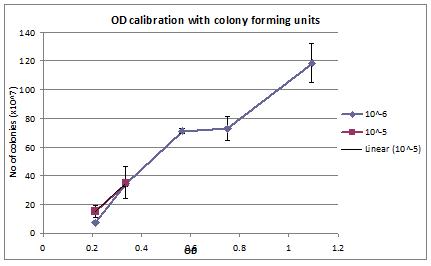Imperial College London/Notebook/2 October 2009
From 2009.igem.org

Contents |
Testing team update
Harvard-GFP
- There is a difference in fluorescence between 28°C and 37°C after compensating for OD.
- Need to adjust the gain so that fluorescence doesn't saturate
- 23rd September
- 30th September
OD calibration
- Preliminary results show that cell number varies with OD. However, the right dilution and enough replicates to overcome the huge variation are required.
- 17th of September (up)
- 23rd of September (awaiting results)
- 25th of September
- 2nd October (awaiting results)
Secondary carbon sources
- There appears to be a plateau in cell number after 6 hours with 0.05% Glucose. However, more data is required to determine if this is the switch point.
- 8th September (up)
- 10th September (up)
- 1st October
GFP pH
- 18th September (awaiting data analysis)
IPTG growth
- IPTG has no effect on cell growth under the concentrations tested (100uM to 5mM)
- This is despit the dual effects of possible toxicity and protein production stress by IPTG on Lac-RFP constructs
- 16th September (up)
Testing
OD calibration 4th run 2nd Oct
Protocol considerations
- Cells were grown overnight in 10ml of M9 media
- The cells were allowed to grow until a high OD in the late morning, then placed in cold room
- OD of around 0.4 to 1.2 was made up, and subsequently diluted up to 10-4 to 10-6
- 100ul of cells were inoculated into each plate
- The OD of the overnight cells were measured again after 3 hours on ice to check if cell number changes during dilution process
Results
Conclusions
- After 3 hours on ice, the OD stays relatively constant
- Shows that number of cells during OD measurement and during plating stay the same. Therefore, OD correlates with the number of cells that are plated.
Suggestions/Improvements
Waiting to be uploaded
 "
"




